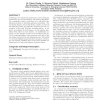Free Online Productivity Tools
i2Speak
i2Symbol
i2OCR
iTex2Img
iWeb2Print
iWeb2Shot
i2Type
iPdf2Split
iPdf2Merge
i2Bopomofo
i2Arabic
i2Style
i2Image
i2PDF
iLatex2Rtf
Sci2ools
GECCO
2009
Springer
2009
Springer
Are evolutionary rule learning algorithms appropriate for malware detection?
In this paper, we evaluate the performance of ten well-known evolutionary and non-evolutionary rule learning algorithms. The comparative study is performed on a real-world classification problem of detecting malicious executables. The executable dataset, used in this study, consists of a total of 189 attributes which are statically extracted from the executables of Microsoft Windows operating system. In our study, we evaluate the performance of rule learning algorithms with respect to four metrics: (1) classification accuracy, (2) the number of rules in the developed rule set, (3) the comprehensibility of the generated rules, and (4) the processing overhead of the rule learning process. The results of our study highlight important shortcomings in evolutionary rule learning classifiers that render them infeasible for deployment in a real-world malware detection system. Categories and Subject Descriptors D.4.6 [Software]: Security and Protection—Invasive software General Terms Algo...
Artificial Intelligence | GECCO 2009 | Rule Learning | Rule Learning Algorithms | Rule Learning Process |
| Added | 26 May 2010 |
| Updated | 26 May 2010 |
| Type | Conference |
| Year | 2009 |
| Where | GECCO |
| Authors | M. Zubair Shafiq, S. Momina Tabish, Muddassar Farooq |
Comments (0)

